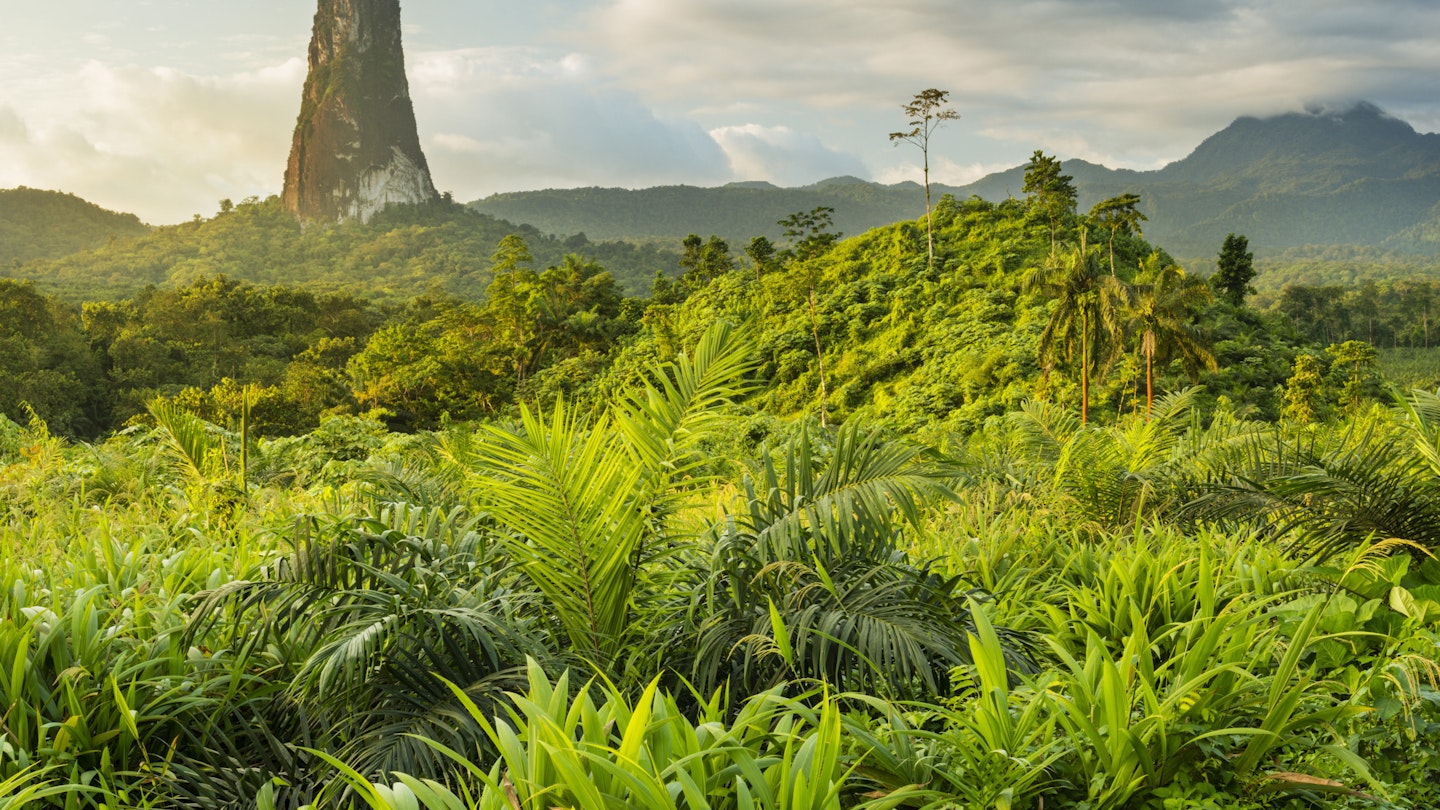From castaway beaches to exquisite chocolate, the remote African island nation of São Tomé and Príncipe has attractions to rival the world’s best.
Rainforest cloaks 90 percent of the island of Príncipe, tumbling down from its volcanic peaks to trespass on the coves that crease its northern coast. Where forest meets sea, palms protrude at opportunistic angles, as if to announce the empty beaches with an unbridled ‘ta-dah!’.
Its beaches are as idyllic as the Seychelles’
Príncipe’s many beaches range from the blissfully remote to lively fishing hubs. On Praia de Santa Rita, snorkellers drift over a small reef, seeking out parrotfish, barracuda, and golden African snapper. To the west, on Praia de Coco, the prints in the sand left by lone wanderers are likely joined only by those of languid dogs. Aside from a pair of jostling tropic birds, Praia Banana, which once starred in a Bacardi ad, is deserted. Turquoise water laps at basalt boulders, while a coconut is tossed about by the waves. It’s all a bit much for one palm, which has crashed out from the sheer bliss of it all.
Its hiking trails as mysterious as Peru’s
It’s late afternoon and the saturated hues of Príncipe’s northwest coast are being painted with even more vivid brushstrokes: in this light, the bandy palm trunks appear almost amber and the wavy leaves of tropical almond trees turn an iridescent green.
The slow way to soak up these shifting colors is to hike one of the six new trails on the island. I set off on the two-mile path from Praia Bom Bom to Ribeira Izé, bouncing across decaying palm leaves and almond husks, littered with fallen breadfruit – soft, fibrous, and swarming with ants. The trail finally emerges at a ruined church, the remains of the first settlement built by Portuguese seafarers in 1471.
It champions slow food as well as Italy does
The motto of São Tomé and Príncipe, ‘leve, leve’ (literally, ‘easy, easy’), is reflected in everything Santomeans do. After a couple of days of disarming conversations and unhurried meals, it’s hard not to follow suit. In a world of abundance where fish literally leap from the sea, why rush?
Chef João Carlos Silva believes that this culture of slow, simple pleasures filters into the nation’s cuisine. The national dish, calulu – dried smoked fish cooked in a soup with breadfruit, palm oil, mosquito herb, and okra – takes six hours to prepare. It’s lunchtime at his restaurant, Roça São João, on the east coast of São Tomé, and the lure of João Carlos’s tasting menu has filled every seat. Guests indulge in the relaxed atmosphere while savouring an array of local delicacies.
Its old capital is as charismatic as Cuba’s
In Príncipe’s main town, Santo António, time seems to slow down. If ‘leve, leve’ is easygoing, the Príncipian equivalent, ‘móli-móli’, is virtually dormant. A boy rolls a tire beside the dawdling Papagaio River. Stray dogs pant in the shade, while locals greet one another with disarming smiles. This triangle of unpaved, potholed streets may be small, but it makes up for it in charm and grandeur.
Its fruits are as exotic as any in the Caribbean
Matabala, jaca, cajá-manga, sape-sape, izaquente, fruta-pão, maquêque, micócó: Santomean fruit bears little resemblance to anything you might find in a local supermarket. Breakfast buffets require an ID guide, as the local produce is both unique and delicious.
It produces chocolate as fine as Switzerland’s
In 1908, São Tomé was the largest producer of cocoa in the world, boasting 800 plantations. However, upon the departure of the Portuguese in 1975, many of these estates fell into decay. Today, the remaining 150 roças serve as a reminder of the rich chocolate heritage of this island nation.
Its wildlife is as unique as the Galápagos’
After a few days on the island, wildlife encounters become casual, almost nonchalant. African grey parrots squabble in tree tops, snakes curl from branches, and tiny kingfishers with improbably long beaks teeter on roots. With a wealth of endemic species due to its isolation, São Tomé and Príncipe boasts a biodiversity that rivals the Galápagos Islands.
It has a skyscraper as bold as Dubai’s
Driving down São Tomé’s remote east coast reveals a string of fishing villages and stunning black sand beaches. The ultimate highlight is Pico Cão Grande, a 668m phonolithic rock tower that towers dramatically over the rainforest, offering breathtaking views and a majestic presence that captivates every visitor.
This article appeared in Lonely Planet Traveller Magazine. Jo Tinsley traveled to São Tomé and Príncipe with support from Rainbow Tours. Lonely Planet contributors do not accept freebies in exchange for positive coverage.
For more travel insights, visit GoTravelDaily.





